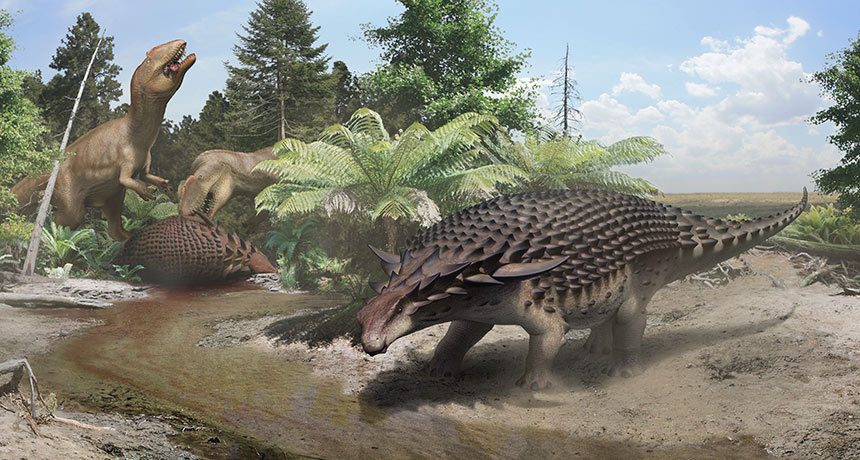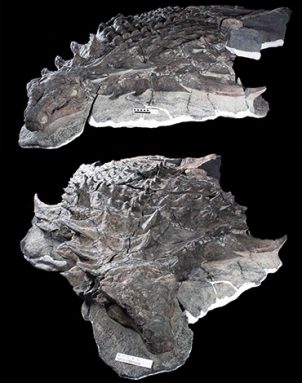Camo might have helped this armored dinosaur avoid becoming lunch
Its colors suggest some ancient predators relied more on sight than smell to hunt

An armored dinosaur found in Alberta, Canada (shown in an artist’s rendering), might have had countershading camouflage. Its back may have been darker than its belly.
Courtesy of the Royal Tyrrell Museum of Palaeontology, Drumheller, Canada
Sometimes body armor just isn’t enough. A car-sized dinosaur covered in bony plates may have sported camo, too, a new study finds. That could mean this plant eater was a target for carnivores that relied more on sight than on smell to find their prey.
The dinosaur is named Borealopelta markmitchelli. It made headlines for being one of the best preserved armored dinosaurs ever unearthed. It had been entombed on its back some 110 million years ago. That was during the Cretaceous period. Soon, layers of fine marine sediments buried its bones. The conditions were ideal for turning this dino into a fossil, notes Caleb Brown. He is a paleontologist at the Royal Tyrrell Museum of Palaeontology in Drumheller, Canada.
He also was a coauthor of a new study that describes the dino’s looks. It appeared August 3 in Current Biology.
The fossil was found in western Canada in 2011. It was special because it showed large amounts of skin and soft tissue as well as the animal’s three-dimensional shape. “Most of the other armored dinosaurs are described based on the skeleton. In this case,” Brown explains, “we can’t see the skeleton because all the skin is still there.”
That skin offered clues to what the dino looked like, including its coloring. “We’re just beginning to realize how important color is. And we’re beginning to have the methods to detect color” in fossils, says Martin Sander. He is a paleontologist at Bonn University in Germany. He was not part of this study.

Melanosomes are cellular structures that often preserve evidence of pigment — coloring — in fossils of animals. But despite ample tissue, the researchers didn’t find any of these. So Brown and his colleagues scouted for less direct evidence.
They looked for molecules that appear when pigments break down. The researchers found about a dozen types of these. They included large amounts of benzothiazole (BEN-zoh-THY-uh-zoal). This is a by-product of the reddish pigment pheomelanin (FEE-oh-MEL-uh-nin). Finding this chemical might mean the dinosaur had been reddish-brown.
Where those pigment by-products were found offers clues to the dinosaur’s appearance. This dino had a thin film of organic (carbon-based) chemicals on its back. They hint of there once having been a pigment there. That layer wasn’t on the belly. Such a pattern suggests countershading. This is when an animal is darker on its back than its underside, Brown explains. Countershading is a simple form of camouflage. It helps animals blend in with the ground when seen from above (or with the sky when seen from below).
Dino coloring
This is not the first time countershading has been proposed for a dinosaur. But finding it on such a large plant eater is somewhat surprising, Brown says. Modern plant eaters that don similar camouflage tend to be smaller. And they’re usually at greater risk of becoming someone’s dinner. This dino’s skin patterning suggests that at least some top predators of its time might have relied more on eyesight than do today’s top carnivores. Modern meat eaters tend to favor smell when hunting, Brown says.
Some experts prefer stronger evidence for claims of coloration. Molecules like benzothiazole can come from melanin. However, they also can come from a number of other sources, such as oils, points out Johan Lindgren. He is a paleontologist at Lund University in Sweden. “What this paper nicely highlights is how little we actually know about the preservation of soft tissues in animal remains. There’s definitely something there. The question is, what are those [molecules], and where do they come from?”
Sander does accept the evidence for the reddish tint. However, it might not be the full story, he says. This dino could have displayed other colors that didn’t linger in the fossil record. But the countershading findings “point out the importance of vision” for dinosaurs, he says. In an era of sharp-eyed predators, camouflagewould have been an advantage for plant eaters — even ones built like tanks.







